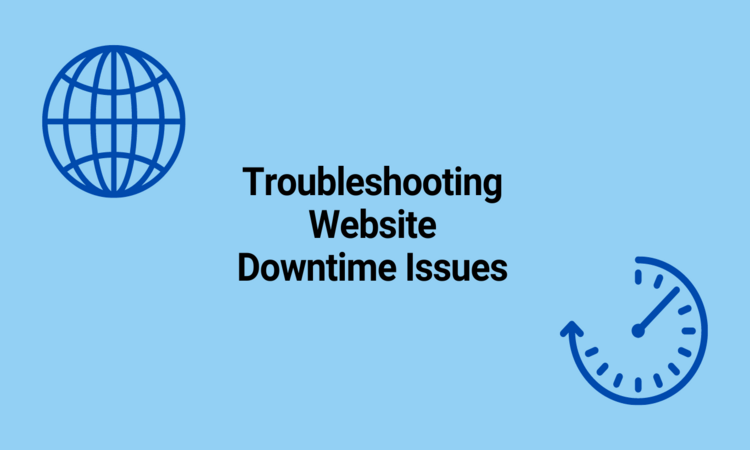Website downtime is a frustrating experience for website owners and visitors alike. It can negatively impact a website’s reputation, search engine rankings, and revenue. When your website goes down, it’s crucial to quickly troubleshoot and resolve the issue. Let’s discover the ways that can help you troubleshoot website downtime issues.
Table of Contents
In this article, we’ll explore common causes of website downtime and provide practical tips on how to troubleshoot website downtime issues.
Understanding Website Downtime
Website downtime refers to a period when a website is inaccessible or unavailable to visitors. It can be caused by various factors such as server issues, software problems, hacking attacks, or network failures. When your website is down, visitors will not be able to access your content, make purchases, or interact with your brand.
Website downtime can be classified into two categories: planned and unplanned. Planned downtime occurs when you intentionally take your website offline for maintenance or upgrades. It’s often scheduled during low traffic periods to minimize the impact on visitors. Unplanned downtime, on the other hand, occurs unexpectedly and can be caused by various issues such as server overload, software bugs, or security breaches.
Related: How to Fix MySQL Port Conflict Issue on XAMPP?
Common Causes of Website Downtime
There are various reasons why your website may go down. Here are some of the most common causes of website downtime:
- Server Issues: Your website is hosted on a server, and if the server experiences problems, your website may become inaccessible. Server issues can be caused by hardware failures, software bugs, or server misconfiguration.
- DNS Issues: DNS (Domain Name System) is responsible for translating domain names into IP addresses that can be used to access websites. If there are issues with the DNS settings, your website may become unavailable.
- Hacking Attacks: Cybercriminals can target your website with various types of hacking attacks such as DDoS attacks, SQL injections, or malware infections. These attacks can cause your website to go down or become compromised.
- Software Problems: If there are bugs or issues with the software running on your website, it can cause your website to become unavailable. This can include issues with content management systems, plugins, or themes.
- Network Failures: If there are issues with the network that connects your website to the internet, it can cause your website to become inaccessible. This can include issues with routers, switches, or internet service providers.
Troubleshooting Website Downtime Issues
When your website goes down, it’s essential to troubleshoot and resolve the issue as quickly as possible.

Here are some practical tips on how to troubleshoot website downtime issues:
1. Check Your Hosting Provider
The first step is to check with your hosting provider to see if there are any server-related issues. Your hosting provider may be able to provide you with information on server status, maintenance schedules, or potential downtime. If there are server issues, they may be able to resolve them for you.
2. Check Your DNS Settings
If there are issues with your DNS settings, your website may become unavailable. You can use online tools such as DNS Checker to check the status of your DNS settings. If there are issues, you may need to contact your domain registrar or hosting provider to resolve them.
3. Check for Hacking Attacks
If you suspect that your website has been hacked, you can use online tools such as Sucuri SiteCheck to scan your website for malware or other security issues. You should also check your website’s access logs to see if there are any suspicious activities.
4. Check Your Website Software
If there are issues with the software running on your website, you may need to troubleshoot the specific software. This can include content management systems, plugins, or themes. You can check for any error messages in the website logs or try disabling plugins one by one to identify the issue.
5. Check Your Network
If there are issues with the network connecting your website to the internet, you may need to troubleshoot the network devices. This can include routers, switches, or internet service providers. You can contact your network provider to identify any issues or try resetting the network devices.
5. Use Monitoring Tools
You can use website monitoring tools such as UptimeRobot or Pingdom to monitor your website’s uptime and receive alerts if your website goes down. These tools can help you quickly identify and troubleshoot downtime issues.
6. Backup Your Website
It’s crucial to regularly backup your website to prevent data loss in case of a downtime or hacking attack. You can use backup plugins or services such as UpdraftPlus or VaultPress to automatically backup your website.
6. Preventing Website Downtime
Prevention is always better than cure when it comes to website downtime. Here are some practical tips on how to prevent website downtime:
7. Choose a Reliable Hosting Provider
Your hosting provider plays a crucial role in website uptime. It’s essential to choose a reliable hosting provider with a good reputation and uptime guarantee. You can also opt for a Content Delivery Network (CDN) to improve website performance and uptime.
8. Keep Your Software Up to Date
Keeping your website software up to date can prevent software-related issues and security vulnerabilities. You should regularly update your content management system, plugins, and themes to the latest version.
9. Implement Security Measures
Implementing website security measures such as SSL certificates, firewalls, and malware scanners can prevent hacking attacks and security breaches that can cause downtime.
10. Optimize Website Performance
Optimizing your website’s performance can improve uptime and user experience. You can use tools such as Google PageSpeed Insights or GTmetrix to identify performance issues and improve website speed.
Related: Avoid 5 Common Website Development Mistakes
Fix Broken Link Error Through HTML Code
Broken Links
Broken links occur when a link on a website points to a page or resource that no longer exists. This can result in a 404 error, which can affect the website’s uptime. One way to fix broken links is by using HTML’s “href” attribute to ensure that links point to valid URLs. Another way is to use a server-side script that checks for broken links and redirects users to the correct page.
Here’s an example of HTML code that fixes a broken link:
<a href="http://example.com/new-page.html">Link text</a>
Fix Slow Website Loading Issue Through HTML Code
Slow website loading
Slow website loading can be caused by a variety of factors, including large image or video files, inefficient coding, or excessive use of third-party scripts. One way to fix this issue is by optimizing the website’s code and reducing the size of images and videos. You can use HTML’s “src” attribute to specify image and video files and use compression techniques like Gzip to reduce their size.
Here’s an example of HTML code that optimizes image loading:
<img src="example.jpg" alt="Example image" width="500" height="500">
Also read: The Importance of Responsive Design in the Mobile Era
Fix Database Connection Error Through HTML Code
Database connection errors
If your website relies on a database to function, connection errors can cause downtime. One way to fix this issue is to ensure that the database credentials in your website’s code are correct. You can also use PHP or other server-side scripts to catch and handle database connection errors.
Here’s an example of PHP code that catches a database connection error:
<?php
$servername = "localhost";
$username = "username";
$password = "password";
$dbname = "myDB";
// Create connection
$conn = new mysqli($servername, $username, $password, $dbname);
// Check connection
if ($conn->connect_error) {
die("Connection failed: " . $conn->connect_error);
}
?>
Related: How to Implement Auto Suggestion in WordPress Search?
Fix Server Errors Through HTML Code
Server errors
Server errors occur when the server hosting your website encounters an issue. Common server errors include the 500 Internal Server Error and the 503 Service Unavailable Error. One way to fix this issue is to ensure that your website’s code is free of syntax errors and is optimized for the server’s operating system. You can also use server-side scripts like PHP to catch and handle server errors.
Here’s an example of PHP code that catches a server error:
<?php
ini_set('display_errors', 1);
ini_set('display_startup_errors', 1);
error_reporting(E_ALL);
// your code here
?>
Also read: How to Implement Infinite Pagination in WordPress?
Fix DNS Resolution Errors Through HTML Code
DNS resolution errors
DNS resolution errors occur when a user’s browser is unable to resolve your website’s domain name to an IP address. This can be caused by a variety of factors, including misconfigured DNS records or DNS server issues. One way to fix this issue is to ensure that your website’s DNS records are correct and up-to-date. You can also use HTML’s “base” element to specify the base URL for your website.
Here’s an example of HTML code that specifies the base URL:
<head>
<base href="http://example.com/">
</head>
Top 5 Tools to Troubleshoot Website Downtime Issues
- Pingdom: Pingdom is a website monitoring tool that helps identify website downtime issues quickly. It offers real-time monitoring and alerts you via email or SMS when your website goes down. It also provides a detailed report on website uptime, response time, and downtime causes.
- UptimeRobot: UptimeRobot is another website monitoring tool that checks your website every five minutes to ensure it is up and running. It offers various monitoring options, including HTTP, HTTPS, Ping, Port, and Keyword. UptimeRobot sends you instant alerts via email, SMS, or push notifications when your website goes down.
- StatusCake: StatusCake is a website monitoring tool that provides uptime, performance, and domain monitoring services. It offers real-time alerts via email, SMS, or push notifications when your website goes down. StatusCake also provides website speed tests, SSL certificate monitoring, and domain expiration alerts.
- GTmetrix: GTmetrix is a website speed and performance analysis tool that helps identify website downtime issues. It provides a detailed report on website speed, performance, and downtime causes. GTmetrix also offers recommendations to optimize your website’s speed and performance.
- Google Search Console: Google Search Console is a free tool offered by Google that helps monitor website downtime issues and other technical issues. It provides a report on website errors, security issues, and search engine performance. Google Search Console also provides recommendations to optimize your website’s search engine rankings and website performance.
Also read: How to Calculate Read Time of an Article or Textual Content?
Importance of Website Uptime
Website uptime is a critical metric that measures the time your website is available and accessible to visitors. A website with high uptime means that visitors can access your website 24/7, leading to a better user experience, increased engagement, and higher conversion rates. On the other hand, website downtime can negatively impact your website’s reputation, revenue, and search engine rankings.
1. Maintaining Reputation
Website uptime is critical for maintaining a positive online reputation. If your website is frequently down, visitors may view your business as unreliable, leading to a loss of trust and potential customers.
2. User Experience
Website uptime directly affects the user experience. When a website is down, users cannot access its content, which can lead to frustration, dissatisfaction, and negative feedback.
3. Revenue Generation
A website that is frequently down can result in lost revenue. Online businesses that rely on their website for generating revenue will suffer if their website experiences prolonged downtime.
4. Search Engine Rankings
Search engines like Google consider website uptime as a factor in their ranking algorithm. Websites that are frequently down are likely to receive lower search engine rankings, which can negatively affect their online visibility.
5. Customer Service
Many businesses offer online customer support through their website. If a website is down, customers may not be able to access support services, leading to dissatisfaction and negative reviews.
6. Brand Awareness
A website that is frequently down can negatively impact brand awareness. A website that is unavailable often may be forgotten, and customers may turn to competitors instead.
7. Website Security
A website that is frequently down can be a sign of a security breach or other technical issues. It is crucial to ensure that your website is up and running to prevent security breaches and other technical issues.
8. Business Operations
Many businesses rely on their website for daily operations. If a website is down, employees may not be able to access crucial information and perform their duties, leading to decreased productivity.
9. Marketing Campaigns
Website uptime is crucial for marketing campaigns. If a website is down during a marketing campaign, potential customers may be unable to access the campaign’s landing page, resulting in lost leads and conversions.
10. Competitiveness
In today’s digital age, online businesses must be available 24/7 to remain competitive. A website that is frequently down will be at a disadvantage compared to competitors with reliable uptime.
Related: Website Performance Optimization
Conclusion
Website downtime can be a frustrating experience for website owners and visitors. Understanding the common causes of website downtime and how to troubleshoot them can help you quickly resolve issues and minimize the impact on your website’s reputation and revenue.
Implementing preventive measures such as choosing a reliable hosting provider, keeping your software up to date, and optimizing website performance can prevent downtime and improve user experience. By following these practical tips, you can ensure that your website stays up and running smoothly.
Hope this blog helped you understand to know and troubleshoot website downtime issues!



